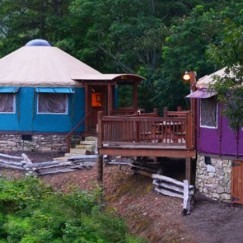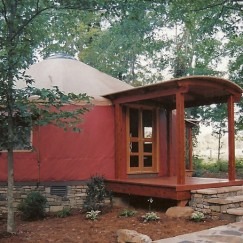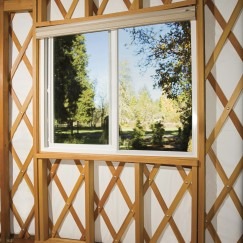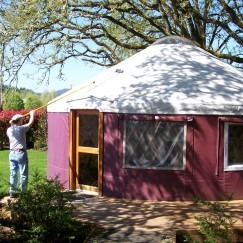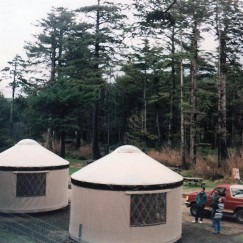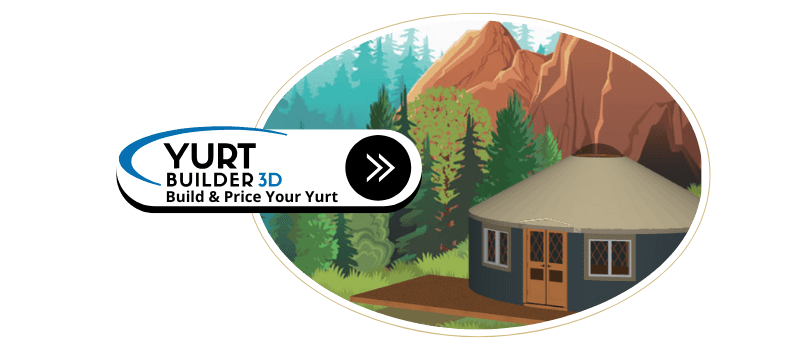Traditional vs. Modern Yurts – What’s the Difference?
A yurt is a round portable structure with a collapsible wood frame and fabric coverings. Architectural Digest has deemed these unique circular structures “architectural wonders.” Traditional yurts have been in continuous use throughout the region of Central Asia for thousands of years.
There are several variations of the basic design and different names used for the structure. Of these variations there are two main types: the ger and the bentwood yurt (also known as the Üy). The Mongolian ger is the older design, which has a relatively heavy center ring (known as the crown or toono) and straight rafters (known as uni) spanning from the center ring to the lattice wall (known as the Khana). This is the design that the modern Pacific Yurt was inspired by and patterned after. Let’s take a look at how traditional Mongolian gers differ from their modern cousins.
Yurts in Ancient Cultures
Mongolian gers feature heavy center rings, straight roof poles and thick, intricately adorned doors and doorframes. One popular decorating theme around ger doors is the geometric “walking pattern”, which represents strength and constant movement. They also feature interior support poles; leaning against these central columns is considered rude in the Mongolian culture. This ancient portable dwelling features felted wool exterior coverings, created from sheep or Yak hair.
As with their modern equivalents, Mongolian gers have accordion lattice walls and a tension band running around the top of the wall. This tension band, originally made of woven cloth or rope, plays a very important role. You see, the rafters create an inward, downward pressure where they meet at the center crown. The outer tension band holds the rafters in a state of constant pressure, creating a strong, stable structure. In Mongolian culture, the crown was passed down from father to son; long-established families pointed to smoke stains on the crown as evidence of their clan’s endurance. An opening in the crown allows sunlight to enter and smoke to escape.
Nomadic Design of Traditional Yurts
The lattice wall of traditional yurts was typically made from willow, birch, or poplar saplings fastened together using leather thongs. It was made in sections that would be lashed together each time the yurt was assembled. This was done so that when the yurt was dismantled the individual components could be transported by a few pack animals.
The design of the traditional yurt was tremendously effective for the people living on the Central Asian steppe since many were nomadic herdsmen. They would move several times a year so that their flocks would have greener pastures to graze. The yurt is lightweight, quick to assemble and its circular shape without eaves or flat surfaces is very aerodynamic, which is important with the winds that occur on the steppe.
Different areas of the yurt’s interior were traditionally assigned to different people. The door always faced to the south, the opposing north section of the yurt was reserved for honored guests, and the eastern section was for the men along with their clothes, tools, and saddles. Women occupied the western area of each yurt; the kitchen was located here as well. A cheery fire burned in the center of the yurt. To this day, many people in Central Asia cherish their traditional gers.
Modern Yurts

Today, the traditional yurt design has been strengthened with contemporary materials; however, wooden lattice walls, straight rafters, and the tension band concept remain primary features of modern yurts. A modern yurt will have a few key architectural differences, including a central ring with acrylic dome skylight that may be opened. Windows are another addition to the traditional yurt and your luxurious modern yurt may even feature insulated glass windows. Durable, high-tech architectural fabric takes the place of felted wool, allowing modern yurt covers to last for a decade or much longer. Several door options are available, including French and fiberglass.
Design Upgrades in Modern Yurts
While ancient yurts were well adapted to withstand the high winds and cold temperatures of the Asian steppe, modern yurts can be even stronger. Modern yurts have evolved to offer unparalleled customization options, making them incredibly versatile and adaptable structures.
The modern yurt is not intended for frequent movement. As such, it is typically built onto a wood platform. Plumbing, electricity, and heating elements may be installed beneath the wood floor. Because of these changes, a larger contemporary yurt may require a couple of days to erect, rather than hours.
More Weather Resistant
Yurts are surprisingly resilient and safe structures in storms. Here at Pacific Yurts, we offer structural upgrades that will withstand extreme conditions. Interconnected points in their structure, along with an aerodynamic shape, provide a high level of stability and flexibility.While most modern yurts do not feature a central column, one can be added to increase snow load capacity, andgutters or water catchment may be added to yurts in wet locales.
Better Temperature Management
Modern yurts have also become much better at regulating temperatures throughout. Customizable features can be added to help keep your yurt warm in colder climates and heating elements can be added to make the space even more comfortable. Reflective insulation is also available to help keep the yurt warmer in the winter and cooler in the summer.
Customizable Yurts for Any Use
One final difference between traditional yurts and their modern counterparts is that now you can create a custom yurt to fit your desires. Contractors can add interior partition walls, modern appliances, lighting, and even lofts into modern yurts to best fit your needs. The circular shape of both modern and ancient yurts creates an energy efficient, strong, and appealing living space. For over four decades, Pacific Yurts has been dedicated to bringing the beauty and ingenuity of this ancient form into the modern age with contemporary yurts for meditation, glamping, getaways, and much more.



